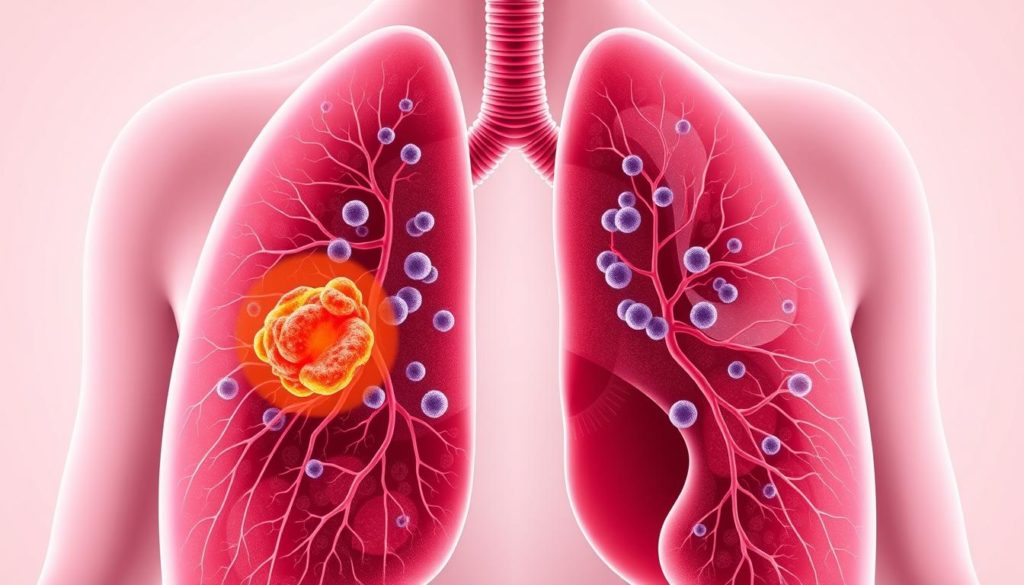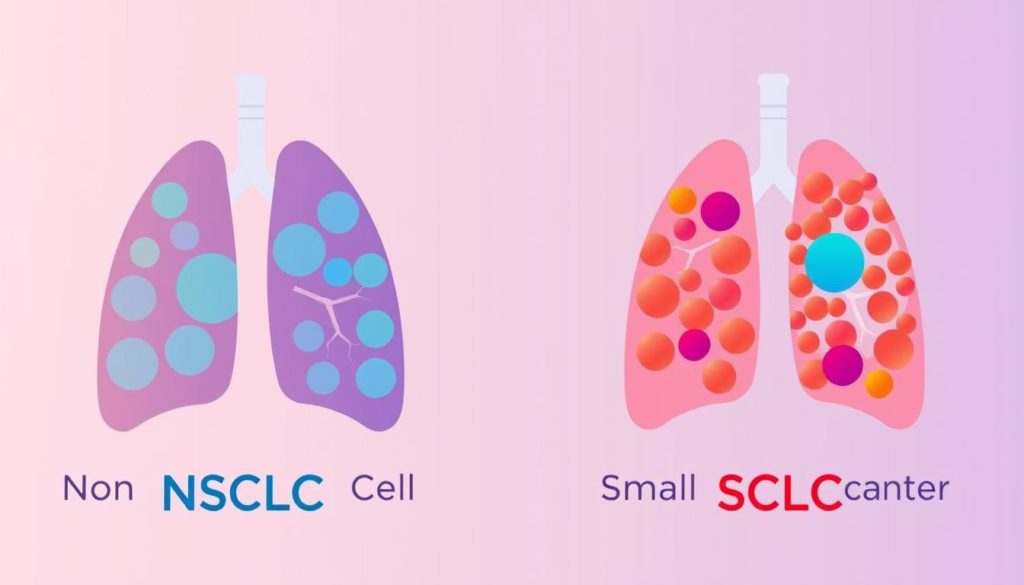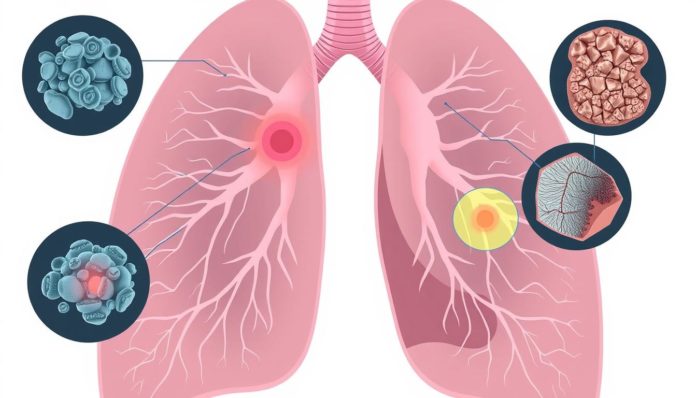About 85% of lung cancer cases are called Non-Small-Cell Lung Cancer (NSCLC). This fact shows the need for more awareness and knowledge of NSCLC.
NSCLC starts in the lungs and can spread to other areas, like lymph nodes or the brain. It has different subtypes, each with unique features. This affects how they grow and respond to treatment. NSCLC grows and spreads more slowly than Small Cell Lung Cancer (SCLC), which is faster. This slow growth changes how doctors treat it and what patients can expect.
We want to give you a full look at Non-Small-Cell Lung Cancer. You’ll learn about how it grows and spreads. With this info, you’ll be better prepared to understand, find, and treat NSCLC.
What is Non-Small-Cell Lung Cancer?
Non-Small-Cell Lung Cancer (NSCLC) is a common lung cancer type that forms in lung tissue. It includes various subtypes and behaves differently than Small Cell Lung Cancer (SCLC). This difference is crucial for treatment responses.
NSCLC is known for its rapid and uncontrollable cell growth. This growth makes up most lung cancer cases. It’s very important for doctors to understand.

At the start, NSCLC cells grow abnormally in the lungs. This can cause tumors and spread cancer cells through lung tissue.
NSCLC is different from other cancers because of its genes and treatment reactions. Knowing this helps in creating specific treatments and controlling the disease.
Defining Non-Small-Cell Lung Cancer is key for handling many lung cancer cases. By understanding NSCLC traits and growth patterns, treatments become more targeted. This is crucial for research and caring for patients with lung cancer.
Grasping NSCLC is vital for anyone exploring lung cancer. It’s the first step towards advanced research and better treatment plans.
Main Types of Lung Cancer
Knowing the key lung cancer types is key to understanding their prognosis and treatment options. This section looks into the main lung cancer forms. They are Non-Small-Cell Lung Cancer (NSCLC) and Small Cell Lung Cancer (SCLC).
Non-Small-Cell Lung Cancer (NSCLC)
NSCLC makes up about 85% of all lung cancer cases. It’s the most common form of lung cancer forms. NSCLC grows more slowly than SCLC. This category includes types like adenocarcinoma and squamous cell carcinoma, each with different features and treatment methods. Most people with NSCLC are diagnosed early, which helps in treating them effectively.

Small Cell Lung Cancer (SCLC)
SCLC is not as common but is very aggressive. It represents 10-15% of lung cancer cases. Often, SCLC is found after it has spread, making successful treatment more challenging. Initially, SCLC responds to chemotherapy and radiation well but is likely to come back, which shows the clear differences in NSCLC vs SCLC.
The main differences between these lung cancer types are shown below:
| Feature | NSCLC | SCLC |
|---|---|---|
| Prevalence | 85% of cases | 10-15% of cases |
| Progression Rate | Slower | Faster |
| Main Treatment Options | Surgery, Radiation, Targeted Therapy | Chemotherapy, Radiation |
| Diagnosis Stage | Early | Advanced |
Major Subtypes of Non-Small-Cell Lung Cancer
Non-Small-Cell Lung Cancer (NSCLC) has three main types: adenocarcinoma, squamous cell carcinoma, and large cell carcinoma. It’s key to know the differences for correct diagnosis and treatment. Each type requires a unique approach.
Adenocarcinoma
Adenocarcinoma is the most seen among NSCLC. It grows in cells that make mucus and is more common in non-smokers. Usually found in the lungs’ outer parts, it may be easier to detect and remove early.
Squamous Cell Carcinoma
Squamous cell carcinoma mainly comes from smoking. It starts in the flat cells of the airways. Often located near the main bronchus, it can cause coughing and chest pain early on.
Large Cell Carcinoma
Large cell carcinoma is rare but very aggressive. It can grow anywhere in the lung and spreads fast, making it hard to catch and treat early. Despite its rarity, quick and thorough treatment is crucial.
| NSCLC Subtype | Common Characteristics | Prevalence |
|---|---|---|
| Adenocarcinoma | Develops in mucus-producing cells; common in non-smokers | Most common |
| Squamous Cell Carcinoma | Associated with smoking; forms in flat cells lining airways | Moderately common |
| Large Cell Carcinoma | Aggressive growth; can appear anywhere in the lung | Least common |
Symptoms of Non-Small-Cell Lung Cancer
Spotting NSCLC symptoms early can really help with treatment and getting better. The signs of lung cancer depend on its stage. But, often people with NSCLC might have:
- Persistent coughing that doesn’t go away
- Changes in existing cough patterns
- Coughing up blood
- Chest pain that worsens with deep breathing or laughing
- Shortness of breath or breathlessness
- Unexplained weight loss
- Fatigue or chronic tiredness
- Repeated lung infections such as bronchitis and pneumonia
The goal of lung cancer detection is to catch these signs early. This leads to quicker treatment. Many factors can change how NSCLC symptoms show up. So, it’s key to see a doctor for a right diagnosis and care plan.
Here’s a quick look at how symptoms can vary by NSCLC stage:
| Symptom | Early Stage | Advanced Stage |
|---|---|---|
| Persistent Cough | Moderate | Severe |
| Coughing Blood | Rare | Common |
| Chest Pain | Mild | Intense |
| Shortness of Breath | Mild | Frequent |
| Weight Loss | Uncommon | Common |
| Fatigue | Mild | Severe |
| Lung Infections | Sporadic | Recurring |
How Non-Small-Cell Lung Cancer is Diagnosed
Doctors use many advanced methods for an accurate NSCLC diagnosis. These tests are key for finding out if the disease is there and how far it has gone. We’ll look at the main ways doctors figure out if someone has Non-Small-Cell Lung Cancer.
Imaging Tests
Lung cancer imaging is the first key step to diagnose NSCLC. Here are some common tests:
- X-rays: Often the first imaging test, highlighting abnormal masses or nodules.
- CT Scans: Provide detailed images of lung structures, aiding in pinpointing the location and size of tumors.
- PET Scans: Help to reveal areas of increased metabolic activity, indicating potential cancerous growths.
- MRI Scans: Used for detailed images when tumors are near vital structures or nerves.
Biopsies
To confirm if it’s lung cancer, biopsies for lung cancer are vital. They involve taking a small piece of tissue for detailed checking. Here are a few methods:
- Bronchoscopy: A thin tube is inserted through the mouth or nose to collect lung tissue.
- Needle Biopsy: A needle gets tissue or fluid from a suspicious area.
- Surgical Biopsy: This is a more deep way to get a bigger tissue sample.
| Diagnostic Method | Description |
|---|---|
| X-rays | Initial test to show masses or nodules. |
| CT Scans | Detailed images of lung structures. |
| PET Scans | Reveal areas of increased metabolic activity. |
| MRI Scans | Detailed images of tumors near vital structures. |
| Bronchoscopy | Tube inserted to collect lung tissue samples. |
| Needle Biopsy | Extracts tissue or fluid with a needle. |
| Surgical Biopsy | Invasive method to obtain larger tissue samples. |
Using both lung cancer imaging and biopsies for lung cancer helps doctors make a right diagnosis. Then, they can plan the best treatment for NSCLC.
Stages of Non-Small-Cell Lung Cancer
Understanding NSCLC stages is key to choosing the best treatment. It starts at stage I, where the tumor is in one place. By stage IV, the cancer has spread far from the original site.
| Stage | Description |
|---|---|
| I | The tumor is only in the lungs and hasn’t reached any lymph nodes. Surgery is often the first step in treatment. |
| II | The tumor is bigger and may have reached nearby lymph nodes. Surgery and chemotherapy are common treatments for this stage. |
| III | Cancer has spread to central chest lymph nodes or those on the other side. Deciding on surgery, radiation, or both depends on the cancer’s spread. |
| IV | Stage IV means the cancer has spread to organs like the brain or liver. Now, treatments aim to ease symptoms and improve life quality. |
Finding the exact stage of NSCLC is a team effort and involves many tests. Correct staging is crucial for a treatment plan that fits the patient’s needs.
Treatment Options for Non-Small-Cell Lung Cancer
Non-Small-Cell Lung Cancer (NSCLC) requires a special approach due to its complexity and types. Which treatment to choose depends on the stage of cancer, the patient’s health, and the type of NSCLC they have.
Surgery
One common treatment for NSCLC is lung cancer surgery. Surgery aims to remove the tumor and nearby affected tissues. In early stages, this can often cure the cancer. Depending on tumor size and location, doctors might do minimally invasive or more extensive surgeries.
Radiation Therapy
Radiation therapy for NSCLC involves using high-energy rays to kill cancer cells. It can work alone or with treatments like surgery or chemo. This method is especially useful for cancers that are tough to reach with surgery.
Targeted Therapy
Targeted therapy for NSCLC goes after specific genetic mutations in cancer cells. It offers a personalized way to fight cancer, aiming at unique markers. Targeting these mutations stops the cancer from growing and helps patients do better.
Each of these NSCLC treatments is key in managing the disease well. The main goal is to better the quality of life for patients.
Effectiveness of Chemotherapy for Lung Cancer
Chemotherapy plays a crucial role in treating NSCLC, often used with surgery and radiation. It targets fast-growing cells, including cancer cells, to reduce symptoms and shrink tumors. This is particularly vital when cancer spreads beyond the lungs.
Chemotherapy’s effectiveness varies, but it’s known to help improve survival rates in NSCLC patients. By combining different drugs, doctors can improve treatment impact and fight cancer cell resistance.
Understanding chemotherapy and its role in lung cancer treatment is key. Here’s what to know:
- Chemotherapy can reach cancer cells all over the body, crucial for metastasized cancers.
- The treatment involves cycles, allowing recovery time between sessions.
- Drug choices depend on the tumor’s traits and the patient’s health.
Pairing chemotherapy with other treatments can boost its effectiveness. This approach is especially useful for advanced-stage patients, where single treatments may not be enough.
| Benefits | Considerations |
|---|---|
| Effective in shrinking tumors | May cause side effects like nausea and fatigue |
| Reduces cancer symptoms | Requires careful monitoring |
| Can be combined with other therapies | Effectiveness varies from person to person |
| Improves survival rates in advanced stages | Risk of developing resistance over time |
As a key treatment for NSCLC, chemotherapy plays a significant role in combating lung cancer. With ongoing research, the strategies for chemotherapy keep improving, bringing new hope for better effectiveness against lung cancer.
Role of Immunotherapy in Treating Lung Cancer
Immunotherapy has become a key player in fighting various lung cancers, such as non-small-cell lung cancer (NSCLC). It boosts the immune system, helping to attack cancer cells more effectively.
This treatment targets proteins that cancer cells use to dodge the immune system. By blocking these proteins, it helps the immune system find and destroy cancer cells.
“Immunotherapy has drastically changed the landscape for advanced NSCLC patients,” said Dr. Antoni Ribas, an immunotherapy specialist. “Patients who were previously out of therapeutic options now have new hope.”
Immunotherapy’s success in NSCLC is seen in the better survival rates of patients. The FDA has approved several drugs because they help people live longer.
- Increased survival rates, especially in advanced stages of NSCLC
- Targeted approach focusing on cancer cell-specific proteins
- Reduction of cancer cell proliferation through enhanced immune response
| Immunotherapy Drug | Application | Effectiveness |
|---|---|---|
| Pembrolizumab (Keytruda) | Advanced NSCLC | Increases overall survival |
| Nivolumab (Opdivo) | Metastatic NSCLC | Improves progression-free survival |
| Atezolizumab (Tecentriq) | Locally advanced or metastatic NSCLC | Enhances immune response |
However, not every patient responds to immunotherapy. Scientists are looking for ways to tell who will benefit most from these treatments.
In short, immunotherapy is a big step forward in lung cancer treatment. It’s making life better for many patients and might change treatment methods even more in the future.
Living with Stage 4 Lung Cancer
Living with Stage 4 lung cancer means facing many challenges. These range from physical to emotional ones. It’s key to focus on the best quality of life while handling advanced NSCLC treatments.
Patients often deal with symptoms like fatigue and pain from treatments such as chemotherapy. They may also have trouble breathing and feel very stressed. Having a good care plan helps manage these issues.
Care for Stage 4 lung cancer includes:
- Symptom management: Using medicines and therapies to feel better.
- Psychological support: Providing help and support to deal with the cancer emotionally.
- Palliative care options: Focusing on improving life quality through symptom control and emotional support.
Here is a summary of what a care plan includes:
| Component | Description | Benefits |
|---|---|---|
| Symptom Management | Medications and therapies to alleviate discomfort. | Improves physical comfort and daily functioning. |
| Psychological Support | Counseling and support groups for emotional well-being. | Helps in coping with stress and anxiety. |
| Palliative Care | Holistic care focusing on symptom relief and support. | Enhances overall quality of life. |
Risk Factors and Prevention
Lung cancer risk factors are crucial for understanding the cause and for prevention methods. Smoking is the main cause of Non-Small-Cell Lung Cancer (NSCLC). Tobacco smoke contains many carcinogens, greatly increasing the chance of getting NSCLC. Radon gas exposure, especially in poorly ventilated homes, also raises lung cancer risks.
Besides smoking, being around asbestos and workplace chemicals is harmful. These substances can damage your lungs over time, leading to cancer. Your family history plays a role as well. Genetics may make you more likely to get lung cancer.
Preventing NSCLC requires taking action. Stopping smoking is the best thing you can do for your lungs. Make sure your home and workplace are safe from radon and asbestos. High-risk people should get regular lung screenings. Catching NSCLC early with CT scans can greatly improve your chances.
FAQ
What are the basics of Non-Small-Cell Lung Cancer?
Non-Small-Cell Lung Cancer (NSCLC) starts in the lungs. It can spread to parts like the lymph nodes or brain. It has different subtypes that react differently to treatments. NSCLC is more common than Small Cell Lung Cancer. It usually grows and spreads more slowly.
How is Non-Small-Cell Lung Cancer defined?
Non-Small-Cell Lung Cancer forms in lung tissue. It accounts for most lung cancer cases. It’s different from Small Cell Lung Cancer because of its unique treatment responses and behavior.
What are the main types of lung cancer?
There are two main types: NSCLC and SCLC. NSCLC is more common. It includes adenocarcinoma and squamous cell carcinoma. SCLC grows faster and is often found too late, which makes it harder to treat.
What are the major subtypes of Non-Small-Cell Lung Cancer?
NSCLC has three main subtypes. Adenocarcinoma starts in mucus cells. Squamous cell carcinoma is often linked to smoking. Large cell carcinoma can grow in any part of the lung. It tends to grow quickly.
What are the symptoms of Non-Small-Cell Lung Cancer?
Symptoms can vary but often include coughing, changes in a cough, and coughing up blood. People might also feel chest pain, get out of breath, feel very tired, lose weight, or get infections like pneumonia.
How is Non-Small-Cell Lung Cancer diagnosed?
Doctors use tests like X-rays and scans to find cancer. Biopsies help confirm the type of lung cancer.
What are the stages of Non-Small-Cell Lung Cancer?
Stages go from I to IV. Stage I is in one spot. Stage IV means the cancer has spread. The stage depends on tumor size and if it has spread.
What are the treatment options for Non-Small-Cell Lung Cancer?
Treatments include surgery, radiation, and targeted therapy. The plan depends on the cancer’s stage, subtype, and the patient’s health.
How effective is chemotherapy for lung cancer?
Chemotherapy is key for treating lung cancer. It kills fast-growing cells. It can lessen symptoms, shrink tumors, and help people live longer.
What is the role of immunotherapy in treating lung cancer?
Immunotherapy helps the immune system attack cancer. It’s promising for some lung cancer patients. It targets cancer cell proteins.
How is living with Stage 4 Lung Cancer?
Stage 4 Lung Cancer means focusing on life quality. People face physical and emotional challenges. Care includes symptom control, support, and palliative options.
What are the risk factors and prevention strategies for Non-Small-Cell Lung Cancer?
Risks include smoking and exposure to dangers like radon. Family history and genes also play a part. To prevent it, quit smoking, avoid harmful substances, and get screened if at risk.


